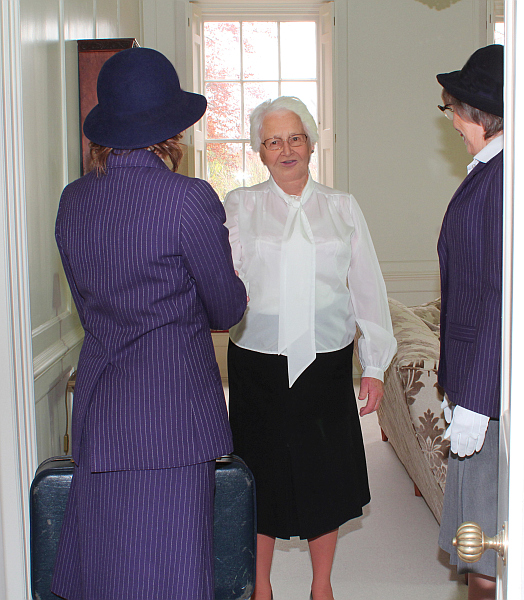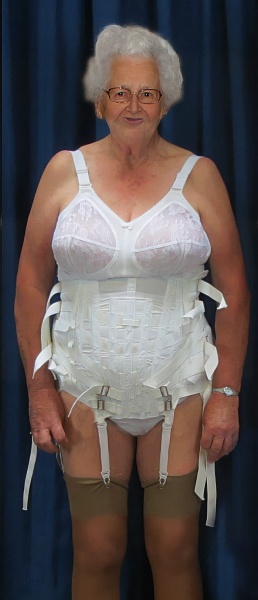
*
The Spirella Corsetière



|
* |
The Spirella Corsetière
|
|
|
|
The corsetiere has been around as long as women have worn corsets, and that
dates back over a thousand years. My main interest is in the corsetieres of the
20th century who worked for the hugely successful Spirella and Spencer
enterprises. For nearly a century the garments that these ladies fitted and sold
barely changed, although a myriad of minute improvements were continuously made.
My knowledge of Spirella and Spencer based in Britain comes from personal
recollections and artifacts from the few remaining corsetieres themselves;
however, there were many other companies that flourished in this trade. Below, I
have tried to describe the art and skill of the corsetiere, which applies to all
companies and all saleswomen. A detailed description of the Spencer method has kindly been donated by Alison,
and I have included a page on the specific details from other companies under
the heading 'Corsetieres'. But here, we
present the Spirella Corsetiere. Mrs. E. a Spirella corsetiere from 1958 and Mrs. H from 1959. Spirella foundations were worn by the corsetieres (apparently to very good effect). In the period that we describe, the corsetiere fought a constant battle against the common perception below. Sadly, in the latter years of the 20th century, she would lose. “To the uninitiated, the word Spirella all too often conjures up a vision of unyielding strong satin, rows of hooks and eyes, yards of lacing, and bones, bones, and more bones” Spirella Magazine January 1958.
* The corsetière's name and address above have been modified from the original as a tribute to the only film I have seen in which a corsetière is portrayed. Joan Sims, who plays Esme Crowfoot, even visited the Spirella factory and, one can imagine, procured the corset that a long-suffering Amelia Bayntun wears in the film "Carry on Loving" (1970). |
|


Contents
|
|
Spirella and Bloomsbury Technical School for Women Spirella Corsetieres of the Past Spirella and the Film Industry
|
|
Training
| One
of the features of the Spirella corset company was that their products were
made-to-measure. Spirella products were never sold in shops. All Spirella's
foundation garments were fitted by corsetieres who were trained at the main
manufacturing centres in New Haven (USA) and Letchworth (UK). Completion of the
training gave the newly fledged corsetiere the coveted
certificate, and a host of
responsibilities to her new employer. The training was comprehensive and not just aimed measuring a women's torso. The corsetiere's entire value to Spirella was that she would sell corsets. Certainly, her ability to measure a client successfully and procure a comfortable and well-fitting garment was essential, both for the well-being of the client, and also for repeat orders and recommendations to the client's friends Flip-chart presentation material for the trainee corsetiere (1938) |

Specific figure problems were illustrated. Spirella, and the other corset houses performed sterling work correcting poor posture and relieving that aching back, however, there is no little salesmanship here. Convince a woman that she has a problem, then money is no object to the removal of that problem!
|
|
Training was essential, and rigorously carried out. After all, a corset is a very powerful garment, and a badly fitted one can result in all sorts of unpleasant problems. In the 1980's, one of the contributing (although not underlying) factors of Spirella's demise was the lack of experience of some corsetieres and, frankly, a deterioration in the quality of the materials. Not only were fewer women wearing corsets, but fewer women even understood a corset . |
|




By the end of the training period, the newly-fledged fitter would know the answer to such testing questions as "Is Madam stout or abdominal?"
The corsetiere would also be a travelling saleslady and her demeanour, posture and attitude would affect her sales. Since the corsetiere lived on her commission, it was in her interest to look good and be expert at her trade. To this end, a large slice of her training involved salesmanship, and some of these ladies became expert at this art. I have no doubt that the vast majority of corsetieres saw their job as a social need and a comfort for the ladies who relied on the support of a corset. Remember that in the 1970's there were still women who had started in corsets as teenagers in the 1915 - 1920 period and who were quite unable to live without one. Nevertheless, the more you sell, you more you make and the various awards presented at the annual corsetiere's gatherings put a premium on the best saleswoman.
The
old saying that a woman needs three corsets, one on the body, one in the drawer
and one in the wash could easily be expanded by an expert saleswoman to include
corsets in the more expensive materials and different colours for special
occasions. The brassiere to match the corset was an obvious seller. If the
client had a daughter or friends present, the possibilities to expand the sale
increased. Of course if the corsetiere herself looked trim and healthy, whatever
her age, then this would be attributed to her foundation garments. Corsetieres
were encouraged to wear what they sold, and in the privacy of the client's home
to show off these garments.
The
travelling saleslady was born out of the emancipation of women in the 1920's
followed by the Great Depression of the 1930's. As the world struggled to
recover from the depression, a woman who could make money by selling corsets
might just keep the family solvent. After the Second World War and moving into
the prosperity of the 1950's, the saleswoman expanded her empire, and in the
1970's in Britain, every phone directory had pages of listed corsetieres, all
with hundreds of clients. Even as the corset gave way to the girdle the
corsetiere flourished.
The
increased liberation of the late 1960's coincided with a declining population of
women who had been used to wearing a corset. Although daughters were put into
corsets in the late 1950's in their late teens for perhaps a wedding or some
special occasion, it wasn't common. A girdle was still well accepted by
teenagers; however, the skill required to fit a corset is not so
necessary in a more flexible garment. Consequently, in the 1960's, store-purchased girdles were increasingly popular and importantly much cheaper. The
move from the girdle to the panty-girdle in the 1970's marked a rapid decline in
customers for the specialised products from Spirella. The customers were not
replaced by their daughters as in times past, and Spirella was left with a static,
aging and sadly declining population of ladies prepared to pay a premium for a
well-fitted foundation garment.
In
the late 1980's Spirella merged with Spencer in Britain. The number of corsetieres
declined as their clientele vanished. No longer was the corsetiere's job paying
well, and the ladies who remained in the profession did so out of a sense of
loyalty, for the profits were minimal. The annual gatherings at Head Office
stopped, the choice of materials was reduced and advertising was effectively
abandoned.
In 2000, I could only find a handful of Spencer corsetieres in Britain, with perhaps a few dozen clients each. Some clients would call only once a year and often sadly never again, as this aging population of ladies passed away. The youngest clients that any of the remaining corsetieres service is about 50, but most are in their 70's to 90's.
Sales Technique


But let's look back to the hey-days of the 1960's, when the corsetiere, trim, smart, knowledgeable and carrying her suitcase of samples, would ring the bell, saying "Good Morning Madam, I'm from Spirella and was given your name by a mutual acquaintance." The corsetiere would be invited in and the sales samples demonstrated. If necessary, and if more than a single lady was present, the saleslady might show off her own garments.





Corsetieres from 1958, 1965 and 1967 (by which time her Spirella income has allowed her to buy one of the first Morris Minis). The appearance and demeanour of the corsetiere was of prime importance. Note the twin set, pearls and gloves.
|
|
Spirella set great store by showing the potential customer what a difference proper corsetry could make. These before and after pictures are a bit exaggerated but they do make the point.
|
Note the mandatory gloves. White looks extremely elegant, however, it marks so easily (a corsetiere's work was quite manual) that most chose brown or black. Getting through the door was important as any salesperson will tell you.
|
|
Once inside the premises of the client, or potential client, the sales routine would begin. The corsetieres were trained as much in sales as in anatomy and fitting. Pity the poor woman in the 'cardie' (left), she hardly looks to be a match for the immaculate attired saleswoman . Hard sales, however, were possibly not productive in the long run. Spirella's products are extremely comfortable and long-lasting if well fitted. Repeat custom is almost guaranteed, however, the last thing a fitter wanted was a client (right) who felt that, perhaps, she had a garment that she did not really need. |
|
The following accounts from the Spirella magazine show how important it was to demonstrate the effectiveness of the product by showing actual examples.
Mrs. H, the corsetiere featured at the top of this section had the following to say in 1959. "I became a corsetiere in 1958 but my interest in Spirella goes back 12 years when I wore my first Spirella girdle. Since then, and long before I became a corsetiere, I would recommend Spirella to friends and acquaintances. When I'm consulting I always show my personal garments, my black 205 girdle and my black long-line bra always being greatly admired. I have sold dozens of black foundations by showing my own, and because black is available in bouquet material, which is one of the most expensive, I find this a good selling point. Many women tell me I don't need Spirella because I'm so slim. I tell them, it's because I wear them that you you think I don't need them."
|
Some corsetieres went that extra step and modelled their underwear in the client's presence, something my friends of today find almost unbelievable. Remember, these women were not professional models, simply normal housewives trying to get commission on their sales. Again in 1965, Mrs. L, a corsetiere from Wandsworth, had this to say (see caption - left). It proves an old adage that one of the best ways to lead or to teach is to set an example for others to follow and show that it works for you.
|
Spirella fitters often gave talks to the Womens Institute (for example) for who better to talk to than an audience of potential clients. |
Of course, if your courage wasn't up to it, perhaps you could persuade your daughter to model for you! From the Spirella magazine of Sept/Oct 1958 comes this account. "At the Spirella carnival week fashion parade at Dartmouth, Corsetiere, Mrs. Jean S. is seen with her daughter-model and a prospective client."
|
Unfortunately, attempting to turn your daughters into images of yourself and an older generation was doomed to failure. The picture below from 1963 shows two girls whose attire could have been worn by their grannies. The revolution of youth was but a year away and never again would teenagers wear anything remotely like twin-set and pearls. |
|
Overseas sales were an important part of Spirella who's empire naturally extended to that of the British Empire. In the days when an overseas posting meant a long sea voyage and probably three or five years on, six months off, the women of the empire needed to plan carefully in advance how many corsets and brassieres they would need. How long would they last in the steamy tropics under the less than careful punishment by the dhobi-wallah? Of course, replacements could be sent out on the next vessel but to maintain that stiff upper torso, one needed a good supply of foundation garments. I have enclosed a couple of orders placed with Spirella by the wife of an electrical engineer in Nigeria. Despite the heat and humidity of the tropics, Mrs. Worthe maintained her composure in a properly laced Spirella 305 and long-line brassiere! |
Measuring and Fitting
For a client to be fitted, a 'measuring garment' was used that looked somewhat like a bra and corset, but with multiple adjustable laces and bones. The garments, which came in many sizes, would be fastened onto the client and the appropriate measurements taken. A myriad of little details would be noted and client's requests as to number and style of suspenders, thickness of bones, plush lining, material and fastenings would be accommodated, but at a price. The technique was used for over eight decades, and this is demonstrated by following the process below. These pictures come from Spirella training manuals, the earliest of which is dated 1914! Sadly, these manuals were no longer issued after the 1960's although the measuring garments carried on for another two decades; prized possessions of the corsetieres.
Let us learn to measure the client using a sequence of pictures that covers half of the 20th century!
|
From 1914 comes this charming series of pictures. The poorly fitting corset on the left is replaced by a proper Spirella resulting in the final product on the right. |
|
The young lady from 1930 (these photographs were issued originally as stereo pairs) shows the modelling garment and the finished product. If she doesn't look ecstatically happy in the final garment, at least she looks less nervous than in the first picture. Perhaps those fluffy slippers bother her. On the other side of the Atlantic (right), the client had no such qualms.
|
Yes; it's a corset not an accordion! |


First of all, the client would be measured in her 'naked strip' (1950)



The modelling garment laced to the desired tension is carefully measured in 1935, 1939, and 1947. In 1957 (below left) the examiner tests one of the aspiring corsetieres.
|
|
|

The modelling garment (above) is made of a peach satin material. Normally, the garments were very functional. They had to be washed regularly and were continuously being tightened and released. This one, I suspect, was more rarely used for wealthier clients. Note, however, the typical features: three lacers, many adjustable hooks and eyes, and the front measurement bone, which could be raised as the client sat down to gauge the longest comfortable length of boning in the garment. Much design went into this garment which carried the patent 1,928,101.



After a few weeks, the final product is delivered and, once again, fitted by the corsetiere. (The ruffles at the top of the stockings were used by Spirella's models to delineate the stocking top for the photograph. This is a pose from 1940.



Demonstrating a sample in 1960 and fitting a brassiere in 1962
To the uninitiated, fitting a brassiere might seem a simple and logical extension of fitting the corset, however, it is far more challenging. There are, of course, many more complex curves and variations, that is why the brassiere was invented many centuries after the corset. Spirella's market in made-to-measure brassieres declined before that of the corset and girdle, largely because inexperienced fitters found it so difficult to measure. It was better to lose commission on the brassiere rather than lose the client altogether. Regard below, the instructions for fitting a strapless brassiere in 1957.

|
|
Either way, it appears that the model is not particularly happy. Perhaps like a number of corsetry models there was an unspoken "I'll model this garment; but don't confuse underwear with sensuality." Something that men always get wrong. |

Measuring and fitting were vital to the whole process. A poorly fitted garment would not just lose a customer, but her friends as well. These cartoons from the Spirella Magazines of 1938 and 1956 reinforce the moralistic element that was part and parcel of the Spirella ethic.


Corsetieres in Real Life
The ideal corsetiere featured strongly in Spirella's advertisements and has been illustrated above; however, there were thousands of more ordinary corsetieres in Britain in the 1960's, many of them women trying to supplement a meager family income, or a hopelessly inadequate state pension. The vast majority of these women were dedicated, loyal and hard-working, but to survive, they had to be saleswomen first and foremost.
|
Any form of transport was used to get their
wares around to the prospective client base,




A typical selection of corsetieres from
Stoke-on-Trent in 1958 charter a bus to make the annual pilgrimage to Letchworth,
whilst an elegant and

Another annual conference in 1958. One could guarantee that these ladies would be wearing 206 or 207 girdles with matching brassieres, and if more than one was supported by the classic 305 corset, I would not be surprised. They look very happy!

At Letchworth, they would gather in the evening. Nary a bulging abdomen to ruin the hang of their rayon dresses (1966).

A group of American corsetieres from 1941 look altogether a tougher breed, however, don't be fooled, whatever the nationality, these ladies were expert saleswomen.
The era hasn't finished yet. Spirella was bought by Spencer in Britain in 1988. Spencer was taken over by Remploy, manufacturers of surgical appliances in the 1990's, and further still by Thamert (UK) in the late 1990's. Yet the corsets are still produced and the corsetieres still exist, albeit in very small numbers. Despite low profit margin, a declining choice of materials and no advertising literature, these dedicated women persevere to serve a clientele that is largely passing away.
I've been fortunate to be fitted by Spirella corsetieres right since the hey-days of the 1960's. Even in the late 1980's, I attended a Mrs E. of Carshalton until 1998, when she could no longer afford to travel to her clients and gave up her business in favour of working as a pharmacist. Mrs. E., who must have then been in her early 50's, wore a 305 corset and reckoned that she was her own youngest client. As the number of clients decreases, so the area covered by each corsetiere increases and the basic costs of running a car soon erode the commission on the garments sold. Sadly, the financial aspects of life ultimately overrule loyalty. Mrs. E. passed me on to a Mrs. I. of Worthing, more than 50 miles from my home base. Although Mrs. I. was prepared to travel to me, she was in her late 70's and I felt obliged to visit her. This charming lady had trained with Spirella in 1958 and had been based in West London. She had fitted many celebrities, including a very famous lady politician (who wore a 206 girdle) and several TV personalities. In the 1960's she remembers that there were several hundred Spirella corsetieres in London. Now she is the only remaining agent in the south-east of England. She fitted me for my last 305 in 1999; however, in subsequent conversations she mentioned that she regularly ordered a 325 corset (front- and back-laced) for a local woman in her mid-40's and showed me one of these that had been returned for a minor alteration in 2001. Other than this younger lady, her clientele consisted of a 50-year-old, a few 60-year-olds and then a few dozen ladies in their 70's to 90's. Charming, energetic and an expert at her dying trade, she is a truly excellent example of the Spirella corsetiere.
Spirella Corsetieres of the Past
The Spirella corsetiere has been around as long as the company. Photographs of models in their corsets become regularly available in brochures only in the mid to late 1920's. Anything photographic prior to that was very much the preserve of the naughty 'French' postcards. Various eras of artwork and style are depicted below from the line drawing of 1913, through the anatomically ill-proportioned flappers of 1930, the wartime austerity of 1943, to, for Spirella, a quite modern 1958.






|
|
To my mind, the picture says so much about the post-War British corsetiere. A younger woman, smartly attired, complete with sample bag and gloves. The new middle class, by no means well off, but, at least, with a small house. The wife's Spirella earnings would be critical to any advancement in their progress through life.
|
|
Mrs. F Wright Spirella's first corsetiere in Britain 1918
Of course, this page wouldn't be complete without a reference to Britain's first Spirella corsetiere, Mrs. F. Wright photographed here in 1910 (Spirella Magazine.) |
The story of Mrs. Fogg that comes from Spirella in Canada demonstrates the strong moralistic tone of the day (1929), where hard work reaped its just rewards.
Corsetieres in Films
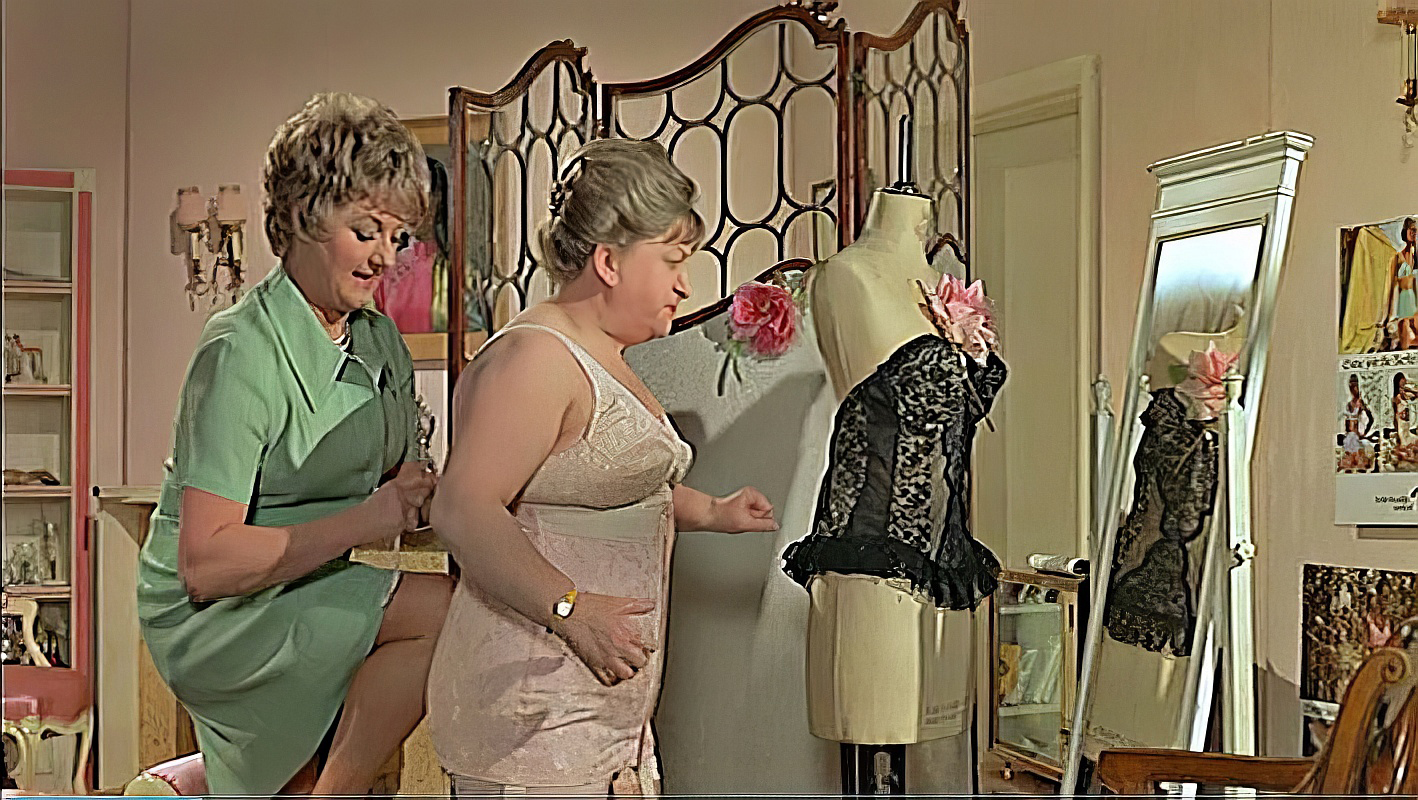
|
Marilyn Monroe on the set of "A Price and a Showgirl" |
|
|
Joan Sims, who was mentioned in the Spirella magazine of 1969, laces a groaning Amelia Bayntun into a pair of Spirella corsets in the film 'Carry on Loving' (1970) "Hold it, hold it - that's right". Considering that many women wear a corset for a bad back, placing one's knee into the lumbar region of the client is probably not a good idea, whatever Scarlett O'Hara might have recommended. In fact, the lovely Miss Sims could well have graced the pages of the Spirella Magazine more often if you consider her figure in the 1960's. I think it is quite unfair that the long-suffering Joan Sims was always portrayed as a frumpy figure. As these photographs show, she is far from frumpy!
|
|
|
I had always thought that the Joan Sims' character of Esme Crowfoot in "Carry On Loving" (1970) was the only such example of a corsetière on film, however, a little gem of information came our way recently. There is a film called "The Girdle of Gold" (1952), that tells the tale of a fortune stashed away in a Welsh Lady's girdle (corselette actually). The corsetière, Mrs. Macie, is played by Tonie MacMillan, her customer wearing a new corselette on the left, Mrs. Griffiths, is played by Maudie Edwards and the young lady on the right, who has just been sold Mrs. Griffiths old corselette, by Petra Davies. |
The Result
The bottom line, of course, was the finished article and the impression that it made. The figure of 1960's woman bears testimony to both the power of her foundation garments and the power of the corsetieres' sales technique.





The styles from 1959 (both pictures on the left) and 1962 (right) show how well the dresses sit on the correct foundation, although by today's standards, the girl in the knit dress would certainly attract attention. All these photographs were taken from the Spirella house magazines of the period.
Interestingly, and from exactly the same period we see Jayne Mansfield alongside her mother (far right). The mother is sensibly attired yet possessed of a good figure, a trait that has been passed onto her daughter and then taken to extremes. I feel the girl in the knitted dress must have seen some of Miss Mansfield's films!
Observations
We asked one of our few remaining corsetiere friends about these snapshots from the early 1960s. The colour photo is a still from a 1962 wedding movie. "What were these women likely to be wearing beneath their smart suits and dresses at that time?" Her answer came quickly for the black & white photos "Corsets or girdles. It's hard to tell which without seeing them move, but there's no doubt that proper foundation garments would be worn." "If I had to guess, and you get quite a good idea after decades in the business, the ladies sitting would be girdle, girdle, corset and corset." I asked if panty-girdles might be worn and our friend regarded me coldly. "This is not America! Panty-girdles didn't come to England before the late 60s."
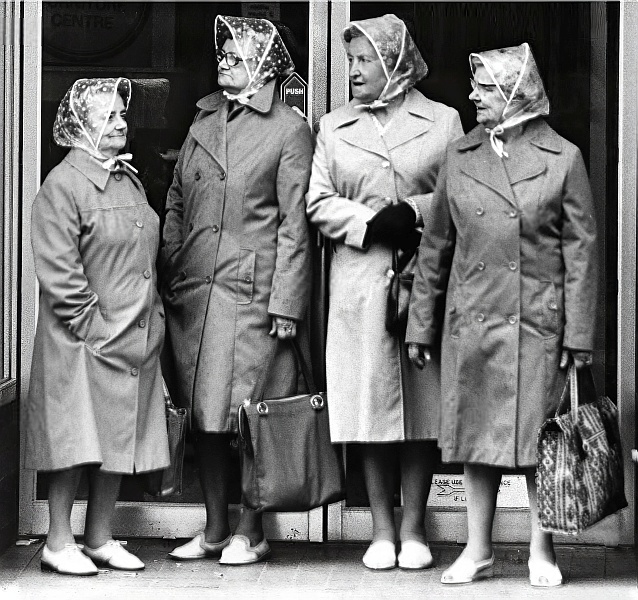
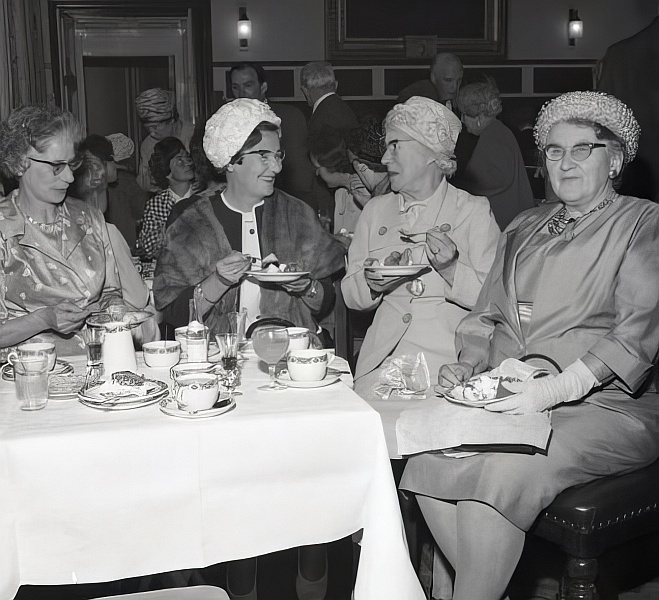
I showed our friend the film from which the colour still was taken.
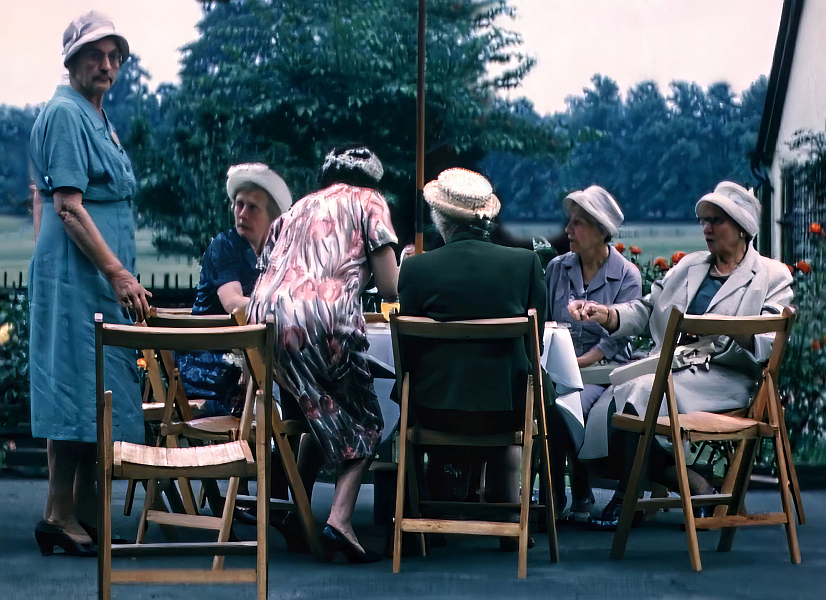
"Aha! Look at the ladies on the left. Both sit down very gingerly and the line of the lady's back, the one in the colourful dress, remains quite rigid. There's a serious one piece garment here, possibly a surgical corset or corselette with surgical steels I wouldn't wonder. As for the rest of the guests it's girdles or corsets again - probably corsets from the look of them."
Being able to assess what your potential client might be wearing is a valuable skill for a corsetière.
Getting inside her expensive apartment and fitting her with an expensive abdominal corset is a triumph.
